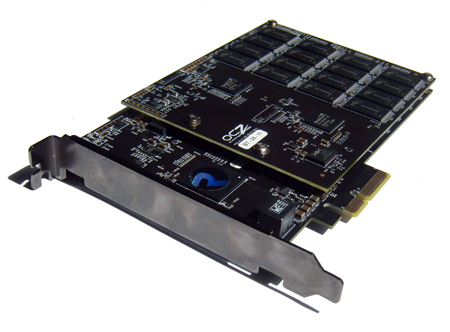The OCZ RevoDrive 3 X2 Preview: Second-Gen SandForce Goes PCIe
Final Words
The RevoDrive 3 X2 continues OCZ's tradition of delivering innovative technology able to serve up blistering performance to enthusiasts. And while this seems to be a bazooka in a bar fight, it's truly the workstation version of products that OCZ is also selling into more enterprise-oriented environments in the Z-Drive R3 and VeloDrive lineups. It's not a business-class product. It's for the power user who is able to tax it using the right workload. If you're not one of those folks, the RevoDrive 3 X2 is seriously overkill.
If you're an enthusiast who knows how to use this drive, OCZ's latest SSD smokes everything we've had pass through our lab. When it comes to random performance, you really only need to hit a queue depth of two to start taking advantage of the architecture's read and write performance. Once you move up to a queue depth of four, you're pushing close to 700 MB/s in both random disciplines.
Sequential performance is naturally even more impressive. Again, you really need a queue depth of at least four in order to take advantage of the RevoDrive 3 X2. Once you're operating in that realm, you hit speeds in excess of 1 GB/s with transfer sizes above 128 KB.
The RevoDrive 3 X2 really needs to run in an environment capable of bombarding it with outstanding requests, which is why you need a queue depth of at least 10 if you want to see those same impressive speeds at smaller transfer sizes (32 KB and larger).
| Header Cell - Column 0 | Price | Price Per GB |
|---|---|---|
| OCZ RevoDrive 3 X2 240 GB | $699.99 (MSRP) | $2.92 |
| OCZ RevoDrive 3 X2 480 GB | $1699.99 (MSRP) | $3.54 |
| OCZ RevoDrive 3 X2 960 GB | $3199.99 (MSRP) | $3.33 |
| Vertex 3 240 GB | $540 (Market) | $2.25 |
| Vertex 3 480 GB | $1750 (Market) | $3.65 |
Alright, so we know that performance is impressive; we were expecting it to be. When it comes to cost, though, you're going to pay a premium for the PCI Express-based card and all of the technology OCZ developed in order to enable it. Most of us shop with some notion of value. That's why the RevoDrive 3 X2 will undoubtedly be compared to the potential of multiple 2.5" SATA-based SSDs harnessed together.
If performance and price both factor into your buying decision, striping a couple of Vertex 3s will almost assuredly enable better value. Unfortunately, that could be the limit of what you can do with an Intel-based board, since they're limited to two SATA 6Gb/s ports. Working around that limitation would require a machine based on an AMD processor, buying an add-in storage controller, or simply purchasing a PCI Express-based SSD like this one. That's the tiny (yet demanding) niche that OCZ is targeting with the RevoDrive 3 X2.
While OCZ delivers unbelievable speed, we'd like to see the company enable TRIM or Unmap support, which the SuperScale controller can purportedly handle on the hardware side. At least it worked around the RevoDrive's firmware footprint, though, by shifting away from the Silicon Image silicon and adopting its own solution.
Get Tom's Hardware's best news and in-depth reviews, straight to your inbox.
-
warmon6 ReplyIt's not a business-class product. It's for the power user who is able to tax it using the right workload. If you're not one of those folks, the RevoDrive 3 X2 is seriously overkill.
OVERKILL?!?!
Nothing is overkill in the computer arena in terms of performance. :p
Just the price can be over kill. o.0 -
acku Santa is going to need a bigger expense account... :)Reply
Personally, I'm hoping that OCZ adds TRIM prior to September.
Cheers,
Andrew Ku
TomsHardware.com -
greenrider02 I saw defense of the Vertex 3's occasional low numbers, but no mention of the solid (and sometimes better) performance that the cheaper and more miserly Crucial m4 showed throughout your tests.Reply
Perhaps you have some bias towards the Vertex 3 that needs reconsideration?
Other than that, $700 seems like a fair price when considering the performace difference, especially if utilized properly, for instance as a high traffic web/corporate server -
acku greenrider02I saw defense of the Vertex 3's occasional low numbers, but no mention of the solid (and sometimes better) performance that the cheaper and more miserly Crucial m4 showed throughout your tests.Perhaps you have some bias towards the Vertex 3 that needs reconsideration?Other than that, $700 seems like a fair price when considering the performace difference, especially if utilized properly, for instance as a high traffic web/corporate serverReply
If you read the first page then you know that I give a nod to Vertex 3s as the fastest MLC based 2.5" SSD. I consider that plenty of love. :).
We'll discuss the lower capacity m4s in another article. FYI, I suggest that you read page 5 and page 6. We are not testing FOB. We are testing steady state. That's part of the reason the SF-based drives are behaving differently with incompressible data.
On your second point, this is in no way targeted toward an enterprise environment (that's what Z-drives are for). There is no redundancy in the array if a single SF controller fails. The whole card is a dud afterward. You can add higher level redundancy, but enterprise customers have so far been nervous on SandForce products. Plus, there's a general preference for hardware vs. software redundancy. (That's them talking not me). Overall, this makes it unacceptable for any enterprise class workload.
